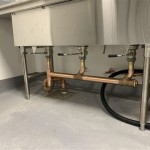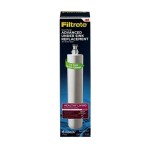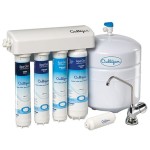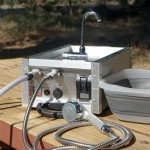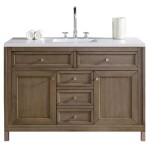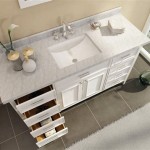Wall Faucets for Bathroom Sinks: A Comprehensive Guide
Wall-mounted faucets, increasingly popular for bathroom sinks, offer a distinct aesthetic and functional advantage over traditional deck-mounted faucets. By positioning the faucet fixtures on the wall rather than directly on the sink or countertop, these faucets create a cleaner, more spacious look, while potentially simplifying cleaning and maintenance. This comprehensive guide explores the various aspects of wall faucets for bathroom sinks, including their benefits, selection criteria, installation considerations, and potential drawbacks.
The core appeal of a wall faucet lies in its ability to free up valuable counter space. In smaller bathrooms, this can be a significant benefit, making the area feel less cluttered and more open. The absence of a faucet base on the countertop also reduces the number of surfaces that need to be cleaned, simplifying the upkeep of the sink area. This design approach also allows for a wider range of sink options, as the sink does not need to be pre-drilled with faucet holes. Therefore, a vessel sink or a sleek, wall-mounted sink can be integrated more seamlessly into the overall bathroom design.
Key Benefits of Wall-Mounted Faucets
Wall-mounted faucets offer a number of advantages that contribute to their growing popularity. These benefits extend beyond mere aesthetics and encompass practical considerations related to space utilization, cleaning convenience, and design flexibility.
One of the primary advantages is, as mentioned, the maximization of countertop space. This is particularly important in smaller bathrooms where every inch counts. By moving the faucet fixtures to the wall, the countertop is freed for other essentials, such as soap dispensers, toiletries, or decorative items. This contributes to a more organized and visually appealing bathroom environment. The cleaner look is amplified by the absence of water splashing around the faucet base itself.
Another significant benefit is the ease of cleaning. Deck-mounted faucets often create hard-to-reach areas around their base where dirt, grime, and water stains can accumulate. Wall-mounted faucets eliminate this issue by removing the base entirely. This makes cleaning the countertop significantly easier and faster, contributing to better hygiene and a more sanitary bathroom environment. Wiping down the countertop becomes a simple, unobstructed task.
Furthermore, wall-mounted faucets offer greater design flexibility. They are compatible with a wider range of sink styles, including vessel sinks, undermount sinks, and wall-mounted sinks. This allows homeowners to choose a sink that perfectly complements their desired aesthetic without being constrained by pre-drilled faucet holes. The ability to mix and match faucet styles with different sink configurations allows for a more personalized and customized bathroom design.
Factors to Consider When Choosing a Wall Faucet
Selecting the right wall-mounted faucet for a bathroom sink requires careful consideration of several factors. These factors include spout reach, water pressure, style and finish, valve compatibility, and installation requirements. Neglecting these aspects can lead to dissatisfaction with the final product and potential installation challenges.
Spout reach is a critical consideration. The distance the spout extends from the wall must be sufficient to allow water to flow comfortably into the sink bowl without splashing onto the countertop or the user. If the spout is too short, the water stream may hit the back of the sink, causing splashing. If it is too long, it may obstruct access to the sink. Accurate measurements of the sink depth and the distance from the wall to the center of the sink basin are essential to determine the appropriate spout reach. Consider also the slope of the sink; a more shallow sink will require a longer reach than a deep one.
Water pressure is another important factor. Wall-mounted faucets, particularly those with complex designs or flow restrictors, may require adequate water pressure to function properly. Low water pressure can result in a weak or inconsistent water flow, which can be frustrating for the user. Before purchasing a wall-mounted faucet, it is advisable to check the water pressure in the bathroom and ensure that it meets the manufacturer's recommendations. If the water pressure is low, a pressure booster pump may be necessary. Another option is to look for faucets specifically designed for low-pressure systems.
The style and finish of the faucet should complement the overall bathroom design. Wall-mounted faucets are available in a wide range of styles, from modern and minimalist to traditional and ornate. The finish should also be chosen to match the other fixtures in the bathroom, such as the showerhead, towel bars, and cabinet hardware. Common finishes include chrome, brushed nickel, oil-rubbed bronze, and matte black. The choice of finish can significantly impact the overall aesthetic of the bathroom.
Valve compatibility is also crucial. Wall-mounted faucets typically require separate valves to control the hot and cold water. It is essential to ensure that the chosen valves are compatible with the faucet and that they meet all applicable plumbing codes. The valves should also be durable and reliable, as they will be responsible for controlling the water flow for years to come. Thermostatic valves can be a good consideration for maintaining constant temperature.
Installation Considerations and Potential Challenges
Installing a wall-mounted faucet is generally more complex than installing a deck-mounted faucet. It typically requires access to the plumbing behind the wall and may involve modifications to the existing plumbing system. Therefore, it is often recommended to hire a qualified plumber to handle the installation. Understanding the installation process and potential challenges is crucial for a successful outcome.
One of the primary challenges is ensuring that the faucet is properly aligned and secured to the wall. The faucet must be mounted at the correct height and angle to ensure that the water flows properly into the sink and that the faucet is aesthetically pleasing. Incorrect alignment can result in water splashing or an uneven appearance. The faucet must also be securely attached to the wall studs to prevent it from becoming loose or unstable over time. The wall itself needs to be sufficiently sturdy to support the faucet and the plumbing connections behind it.
Another potential challenge is access to the plumbing behind the wall. In some cases, it may be necessary to cut into the wall to access the water supply lines and drainpipe. This can be a messy and time-consuming process. It is important to carefully plan the installation to minimize the amount of cutting required. Furthermore, it is essential to ensure that the plumbing connections are properly sealed to prevent leaks. Leaks behind the wall can cause significant water damage and may be difficult to detect.
Accessibility to shut-off valves also needs to be considered. Typically, shut-off valves should be installed close to the faucet for easy access in case of repairs or emergencies. With wall-mounted faucets, these valves are often hidden behind the wall. Access panels should be installed to allow access to the valves without having to cut into the wall. Failing to do so can make future maintenance and repairs much more difficult and costly.
Finally, code compliance is an essential consideration. All plumbing installations must comply with local plumbing codes. These codes specify requirements for pipe size, materials, and installation methods. It is important to consult with a qualified plumber to ensure that the installation meets all applicable codes. Failure to comply with these codes can result in fines or require rework. Ensuring compliance from the outset will prevent future problems and ensure a safe and functional plumbing system.
While wall-mounted faucets offer aesthetic and functional benefits, a thorough understanding of the selection criteria, installation considerations, and potential challenges is paramount. With careful planning and professional installation, a wall-mounted faucet can be a stylish and practical addition to any bathroom.

Vigo Cass Two Handle Wall Mount Bathroom Faucet In Matte Brushed Gold Vg05007mg The Home

Fontana Chrome Wall Mount Sink Faucet At Fontanashowers Com

Pros And Cons Of Wall Mount Faucets Hawaii Interior Designer Sachi Lord

Modern Bathroom Sink Faucets Isenberg

Vigo Cass Two Handle Wall Mount Bathroom Faucet In Matte Brushed Gold Vg05007mg The Home

Vigo Black Sottile Matteshell Bathroom Vessel Sink And Titus Wall Mount Faucet In Matte Brushed Gold With Pop Up Drain

Mondawe Matte Black Wall Mount 2 Handle Waterfall Bathroom Sink Faucet In The Faucets Department At Com

Mercer Cross Handle Wall Mounted Bathroom Sink Faucet Pottery Barn

Litze Single Handle Wall Mount Bathroom Faucet Faucets

Wall Mount Sink Faucet With Waterfall Spout Zen Bathworks
